Comprehensive Analysis of Complex Project Management Strategies
VerifiedAdded on 2023/06/03
|23
|6811
|90
Essay
AI Summary
This essay provides a comprehensive overview of complex project management, differentiating it from simple and complicated projects. It delves into the causes of project complexity, such as multiplicity, interdependence, diversity, and novelty, and explores the issues and implications that arise in complex projects, including stakeholder misalignment and political pressures. The essay also examines various tools and techniques for managing project complexity, emphasizing the importance of transformational leadership and effective communication. By analyzing these aspects, the essay aims to assist project managers in effectively dealing with complexity and achieving project success. Desklib offers this essay along with other resources for students.

Complex Project Management
Paraphrase This Document
Need a fresh take? Get an instant paraphrase of this document with our AI Paraphraser
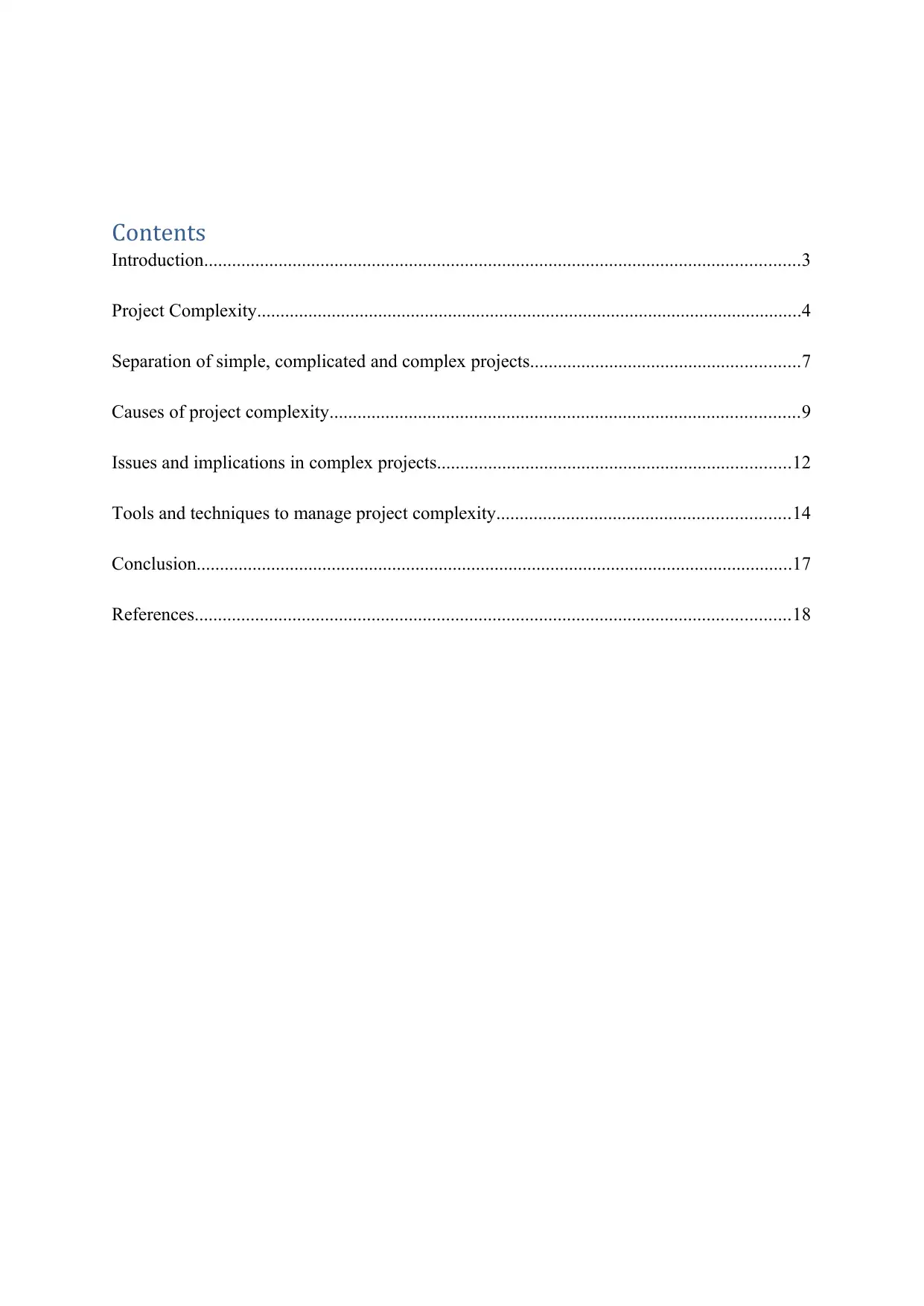
Contents
Introduction................................................................................................................................3
Project Complexity.....................................................................................................................4
Separation of simple, complicated and complex projects..........................................................7
Causes of project complexity.....................................................................................................9
Issues and implications in complex projects............................................................................12
Tools and techniques to manage project complexity...............................................................14
Conclusion................................................................................................................................17
References................................................................................................................................18
Introduction................................................................................................................................3
Project Complexity.....................................................................................................................4
Separation of simple, complicated and complex projects..........................................................7
Causes of project complexity.....................................................................................................9
Issues and implications in complex projects............................................................................12
Tools and techniques to manage project complexity...............................................................14
Conclusion................................................................................................................................17
References................................................................................................................................18
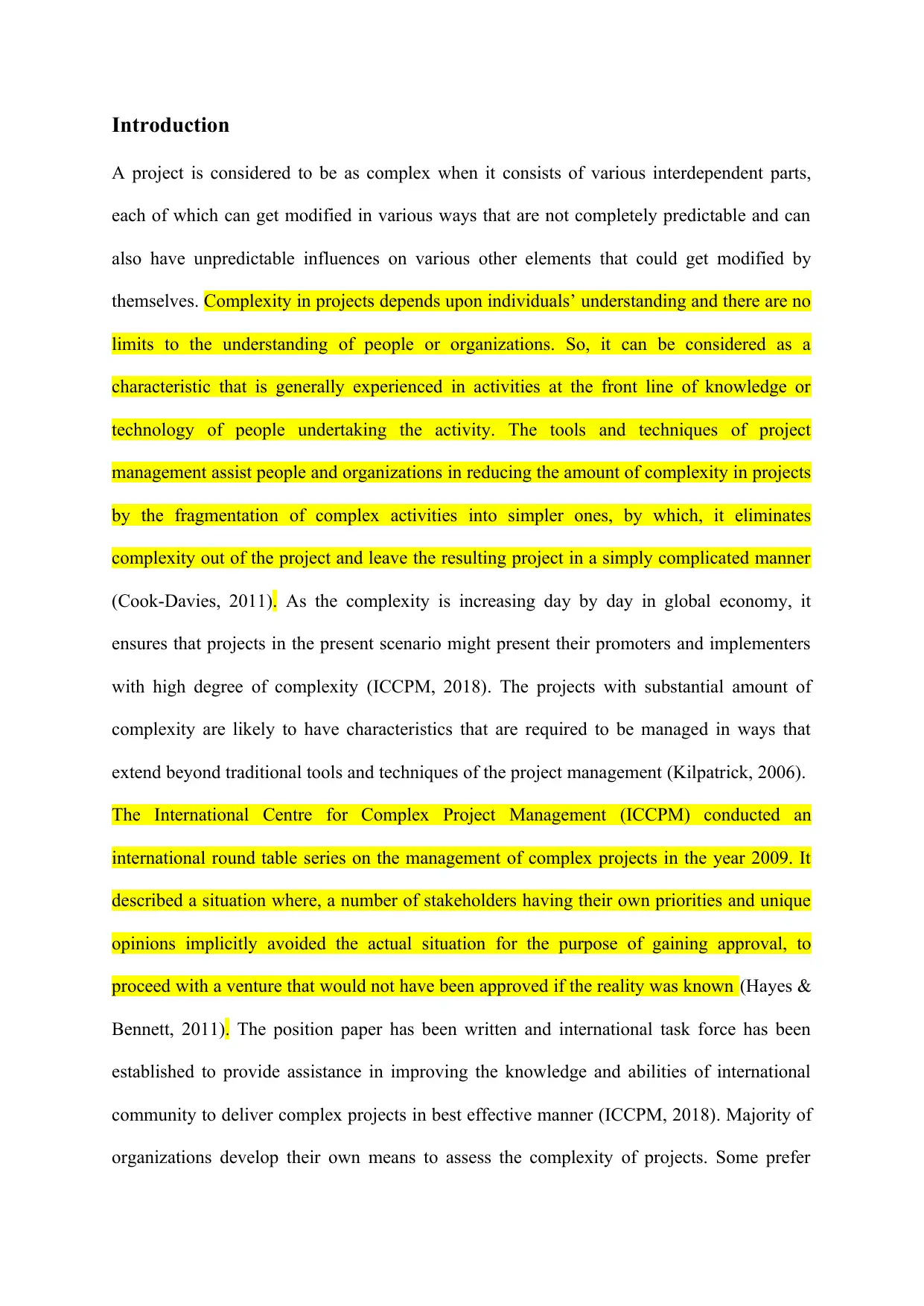
Introduction
A project is considered to be as complex when it consists of various interdependent parts,
each of which can get modified in various ways that are not completely predictable and can
also have unpredictable influences on various other elements that could get modified by
themselves. Complexity in projects depends upon individuals’ understanding and there are no
limits to the understanding of people or organizations. So, it can be considered as a
characteristic that is generally experienced in activities at the front line of knowledge or
technology of people undertaking the activity. The tools and techniques of project
management assist people and organizations in reducing the amount of complexity in projects
by the fragmentation of complex activities into simpler ones, by which, it eliminates
complexity out of the project and leave the resulting project in a simply complicated manner
(Cook-Davies, 2011). As the complexity is increasing day by day in global economy, it
ensures that projects in the present scenario might present their promoters and implementers
with high degree of complexity (ICCPM, 2018). The projects with substantial amount of
complexity are likely to have characteristics that are required to be managed in ways that
extend beyond traditional tools and techniques of the project management (Kilpatrick, 2006).
The International Centre for Complex Project Management (ICCPM) conducted an
international round table series on the management of complex projects in the year 2009. It
described a situation where, a number of stakeholders having their own priorities and unique
opinions implicitly avoided the actual situation for the purpose of gaining approval, to
proceed with a venture that would not have been approved if the reality was known (Hayes &
Bennett, 2011). The position paper has been written and international task force has been
established to provide assistance in improving the knowledge and abilities of international
community to deliver complex projects in best effective manner (ICCPM, 2018). Majority of
organizations develop their own means to assess the complexity of projects. Some prefer
A project is considered to be as complex when it consists of various interdependent parts,
each of which can get modified in various ways that are not completely predictable and can
also have unpredictable influences on various other elements that could get modified by
themselves. Complexity in projects depends upon individuals’ understanding and there are no
limits to the understanding of people or organizations. So, it can be considered as a
characteristic that is generally experienced in activities at the front line of knowledge or
technology of people undertaking the activity. The tools and techniques of project
management assist people and organizations in reducing the amount of complexity in projects
by the fragmentation of complex activities into simpler ones, by which, it eliminates
complexity out of the project and leave the resulting project in a simply complicated manner
(Cook-Davies, 2011). As the complexity is increasing day by day in global economy, it
ensures that projects in the present scenario might present their promoters and implementers
with high degree of complexity (ICCPM, 2018). The projects with substantial amount of
complexity are likely to have characteristics that are required to be managed in ways that
extend beyond traditional tools and techniques of the project management (Kilpatrick, 2006).
The International Centre for Complex Project Management (ICCPM) conducted an
international round table series on the management of complex projects in the year 2009. It
described a situation where, a number of stakeholders having their own priorities and unique
opinions implicitly avoided the actual situation for the purpose of gaining approval, to
proceed with a venture that would not have been approved if the reality was known (Hayes &
Bennett, 2011). The position paper has been written and international task force has been
established to provide assistance in improving the knowledge and abilities of international
community to deliver complex projects in best effective manner (ICCPM, 2018). Majority of
organizations develop their own means to assess the complexity of projects. Some prefer
⊘ This is a preview!⊘
Do you want full access?
Subscribe today to unlock all pages.

Trusted by 1+ million students worldwide
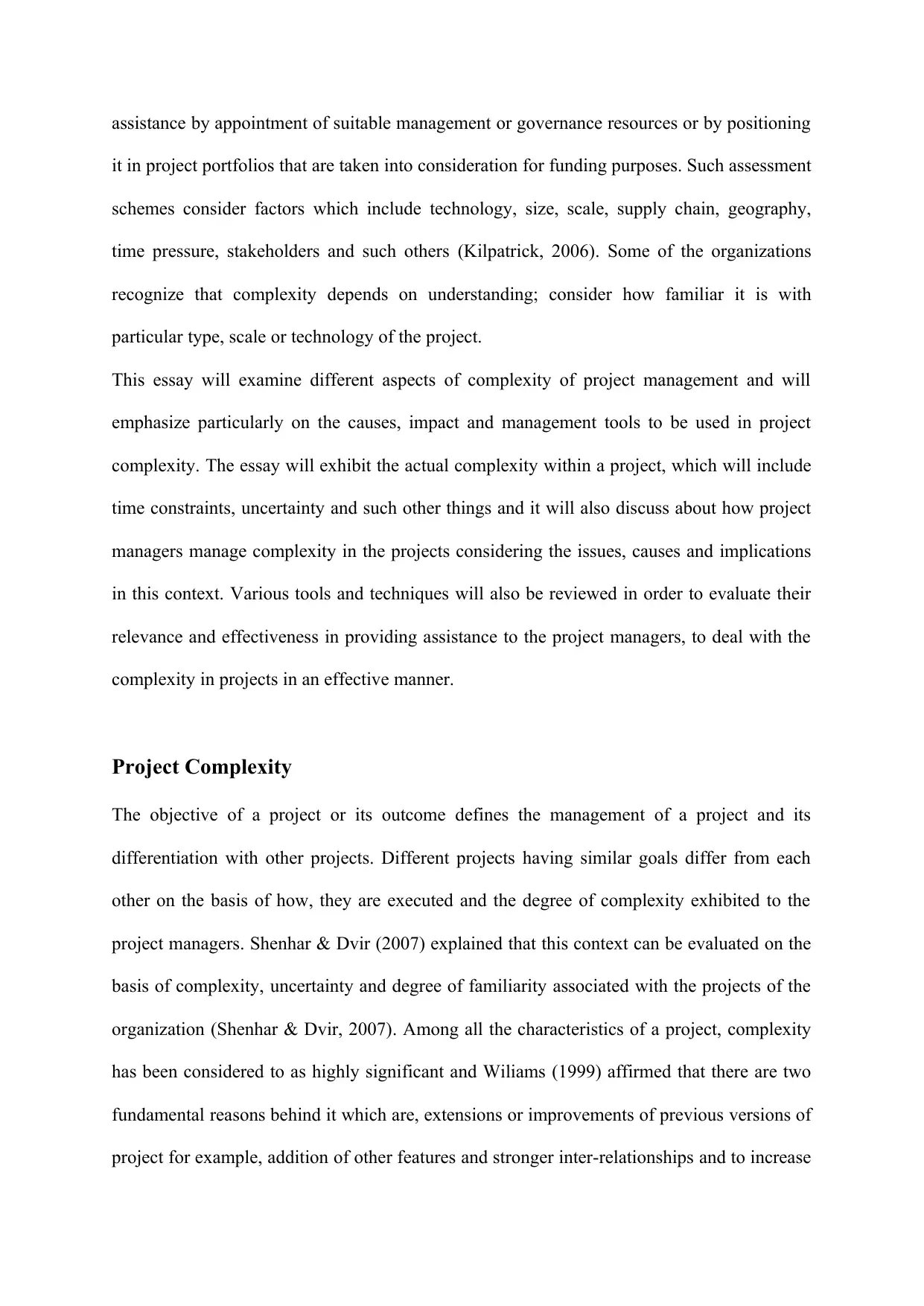
assistance by appointment of suitable management or governance resources or by positioning
it in project portfolios that are taken into consideration for funding purposes. Such assessment
schemes consider factors which include technology, size, scale, supply chain, geography,
time pressure, stakeholders and such others (Kilpatrick, 2006). Some of the organizations
recognize that complexity depends on understanding; consider how familiar it is with
particular type, scale or technology of the project.
This essay will examine different aspects of complexity of project management and will
emphasize particularly on the causes, impact and management tools to be used in project
complexity. The essay will exhibit the actual complexity within a project, which will include
time constraints, uncertainty and such other things and it will also discuss about how project
managers manage complexity in the projects considering the issues, causes and implications
in this context. Various tools and techniques will also be reviewed in order to evaluate their
relevance and effectiveness in providing assistance to the project managers, to deal with the
complexity in projects in an effective manner.
Project Complexity
The objective of a project or its outcome defines the management of a project and its
differentiation with other projects. Different projects having similar goals differ from each
other on the basis of how, they are executed and the degree of complexity exhibited to the
project managers. Shenhar & Dvir (2007) explained that this context can be evaluated on the
basis of complexity, uncertainty and degree of familiarity associated with the projects of the
organization (Shenhar & Dvir, 2007). Among all the characteristics of a project, complexity
has been considered to as highly significant and Wiliams (1999) affirmed that there are two
fundamental reasons behind it which are, extensions or improvements of previous versions of
project for example, addition of other features and stronger inter-relationships and to increase
it in project portfolios that are taken into consideration for funding purposes. Such assessment
schemes consider factors which include technology, size, scale, supply chain, geography,
time pressure, stakeholders and such others (Kilpatrick, 2006). Some of the organizations
recognize that complexity depends on understanding; consider how familiar it is with
particular type, scale or technology of the project.
This essay will examine different aspects of complexity of project management and will
emphasize particularly on the causes, impact and management tools to be used in project
complexity. The essay will exhibit the actual complexity within a project, which will include
time constraints, uncertainty and such other things and it will also discuss about how project
managers manage complexity in the projects considering the issues, causes and implications
in this context. Various tools and techniques will also be reviewed in order to evaluate their
relevance and effectiveness in providing assistance to the project managers, to deal with the
complexity in projects in an effective manner.
Project Complexity
The objective of a project or its outcome defines the management of a project and its
differentiation with other projects. Different projects having similar goals differ from each
other on the basis of how, they are executed and the degree of complexity exhibited to the
project managers. Shenhar & Dvir (2007) explained that this context can be evaluated on the
basis of complexity, uncertainty and degree of familiarity associated with the projects of the
organization (Shenhar & Dvir, 2007). Among all the characteristics of a project, complexity
has been considered to as highly significant and Wiliams (1999) affirmed that there are two
fundamental reasons behind it which are, extensions or improvements of previous versions of
project for example, addition of other features and stronger inter-relationships and to increase
Paraphrase This Document
Need a fresh take? Get an instant paraphrase of this document with our AI Paraphraser
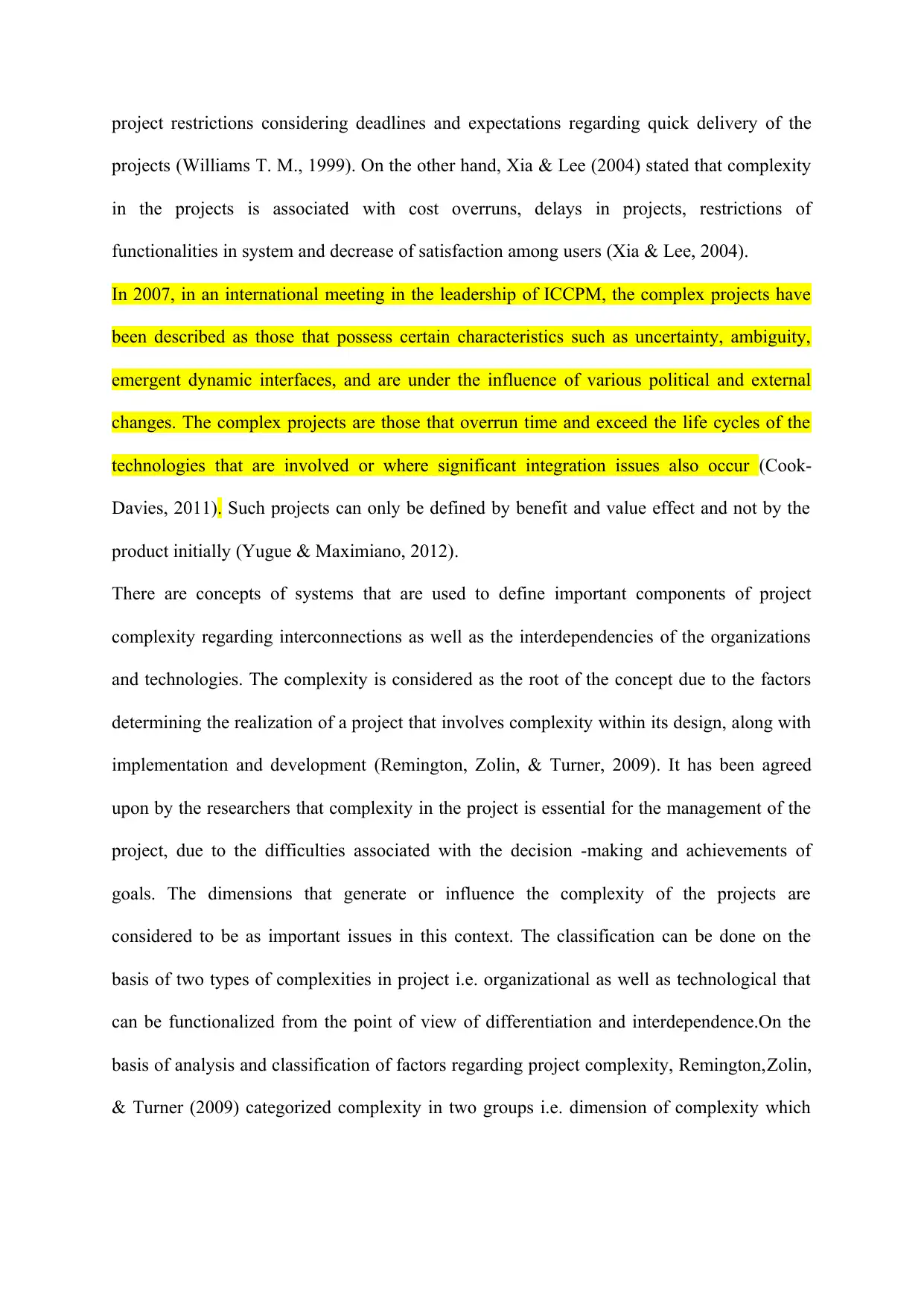
project restrictions considering deadlines and expectations regarding quick delivery of the
projects (Williams T. M., 1999). On the other hand, Xia & Lee (2004) stated that complexity
in the projects is associated with cost overruns, delays in projects, restrictions of
functionalities in system and decrease of satisfaction among users (Xia & Lee, 2004).
In 2007, in an international meeting in the leadership of ICCPM, the complex projects have
been described as those that possess certain characteristics such as uncertainty, ambiguity,
emergent dynamic interfaces, and are under the influence of various political and external
changes. The complex projects are those that overrun time and exceed the life cycles of the
technologies that are involved or where significant integration issues also occur (Cook-
Davies, 2011). Such projects can only be defined by benefit and value effect and not by the
product initially (Yugue & Maximiano, 2012).
There are concepts of systems that are used to define important components of project
complexity regarding interconnections as well as the interdependencies of the organizations
and technologies. The complexity is considered as the root of the concept due to the factors
determining the realization of a project that involves complexity within its design, along with
implementation and development (Remington, Zolin, & Turner, 2009). It has been agreed
upon by the researchers that complexity in the project is essential for the management of the
project, due to the difficulties associated with the decision -making and achievements of
goals. The dimensions that generate or influence the complexity of the projects are
considered to be as important issues in this context. The classification can be done on the
basis of two types of complexities in project i.e. organizational as well as technological that
can be functionalized from the point of view of differentiation and interdependence.On the
basis of analysis and classification of factors regarding project complexity, Remington,Zolin,
& Turner (2009) categorized complexity in two groups i.e. dimension of complexity which
projects (Williams T. M., 1999). On the other hand, Xia & Lee (2004) stated that complexity
in the projects is associated with cost overruns, delays in projects, restrictions of
functionalities in system and decrease of satisfaction among users (Xia & Lee, 2004).
In 2007, in an international meeting in the leadership of ICCPM, the complex projects have
been described as those that possess certain characteristics such as uncertainty, ambiguity,
emergent dynamic interfaces, and are under the influence of various political and external
changes. The complex projects are those that overrun time and exceed the life cycles of the
technologies that are involved or where significant integration issues also occur (Cook-
Davies, 2011). Such projects can only be defined by benefit and value effect and not by the
product initially (Yugue & Maximiano, 2012).
There are concepts of systems that are used to define important components of project
complexity regarding interconnections as well as the interdependencies of the organizations
and technologies. The complexity is considered as the root of the concept due to the factors
determining the realization of a project that involves complexity within its design, along with
implementation and development (Remington, Zolin, & Turner, 2009). It has been agreed
upon by the researchers that complexity in the project is essential for the management of the
project, due to the difficulties associated with the decision -making and achievements of
goals. The dimensions that generate or influence the complexity of the projects are
considered to be as important issues in this context. The classification can be done on the
basis of two types of complexities in project i.e. organizational as well as technological that
can be functionalized from the point of view of differentiation and interdependence.On the
basis of analysis and classification of factors regarding project complexity, Remington,Zolin,
& Turner (2009) categorized complexity in two groups i.e. dimension of complexity which
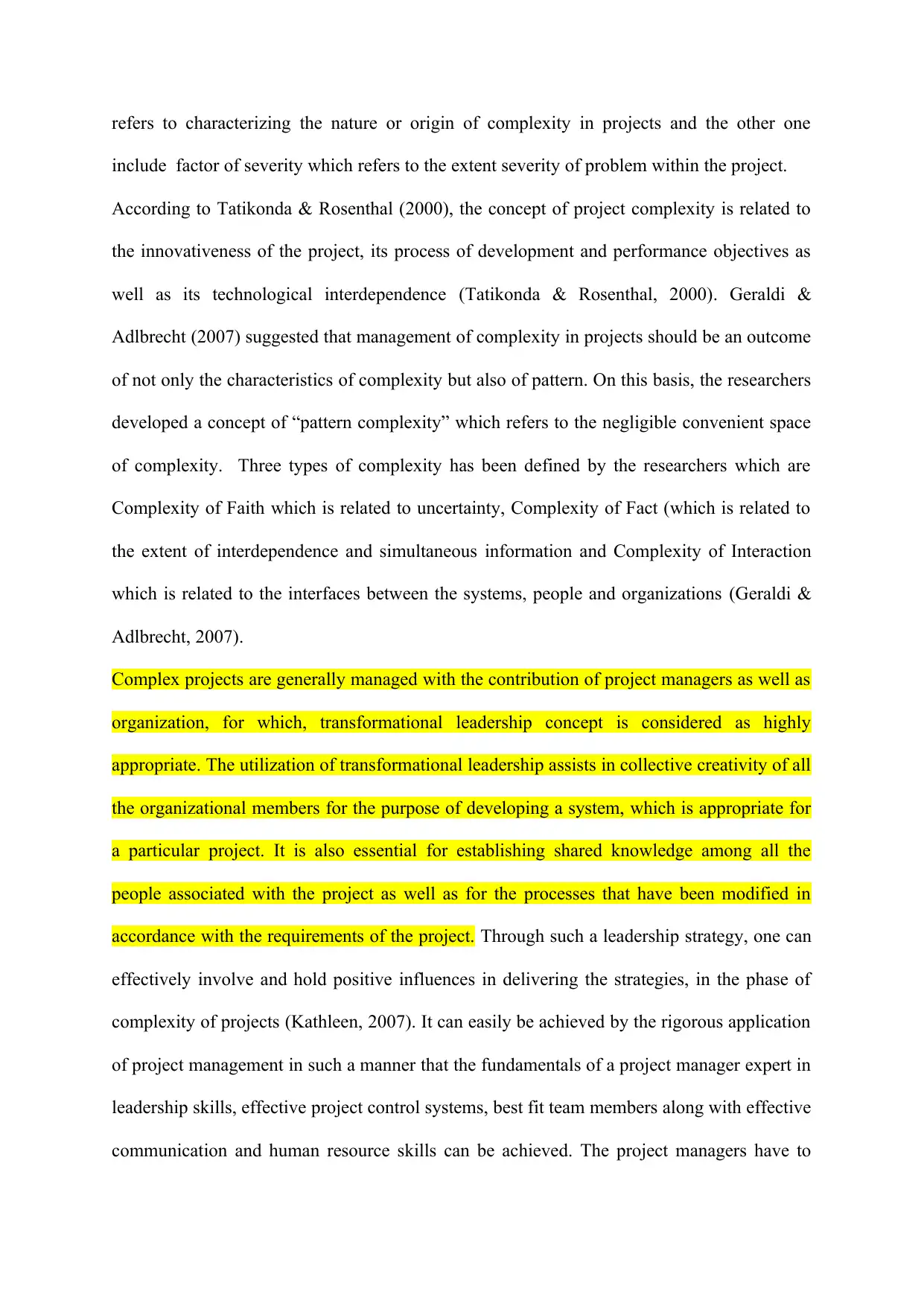
refers to characterizing the nature or origin of complexity in projects and the other one
include factor of severity which refers to the extent severity of problem within the project.
According to Tatikonda & Rosenthal (2000), the concept of project complexity is related to
the innovativeness of the project, its process of development and performance objectives as
well as its technological interdependence (Tatikonda & Rosenthal, 2000). Geraldi &
Adlbrecht (2007) suggested that management of complexity in projects should be an outcome
of not only the characteristics of complexity but also of pattern. On this basis, the researchers
developed a concept of “pattern complexity” which refers to the negligible convenient space
of complexity. Three types of complexity has been defined by the researchers which are
Complexity of Faith which is related to uncertainty, Complexity of Fact (which is related to
the extent of interdependence and simultaneous information and Complexity of Interaction
which is related to the interfaces between the systems, people and organizations (Geraldi &
Adlbrecht, 2007).
Complex projects are generally managed with the contribution of project managers as well as
organization, for which, transformational leadership concept is considered as highly
appropriate. The utilization of transformational leadership assists in collective creativity of all
the organizational members for the purpose of developing a system, which is appropriate for
a particular project. It is also essential for establishing shared knowledge among all the
people associated with the project as well as for the processes that have been modified in
accordance with the requirements of the project. Through such a leadership strategy, one can
effectively involve and hold positive influences in delivering the strategies, in the phase of
complexity of projects (Kathleen, 2007). It can easily be achieved by the rigorous application
of project management in such a manner that the fundamentals of a project manager expert in
leadership skills, effective project control systems, best fit team members along with effective
communication and human resource skills can be achieved. The project managers have to
include factor of severity which refers to the extent severity of problem within the project.
According to Tatikonda & Rosenthal (2000), the concept of project complexity is related to
the innovativeness of the project, its process of development and performance objectives as
well as its technological interdependence (Tatikonda & Rosenthal, 2000). Geraldi &
Adlbrecht (2007) suggested that management of complexity in projects should be an outcome
of not only the characteristics of complexity but also of pattern. On this basis, the researchers
developed a concept of “pattern complexity” which refers to the negligible convenient space
of complexity. Three types of complexity has been defined by the researchers which are
Complexity of Faith which is related to uncertainty, Complexity of Fact (which is related to
the extent of interdependence and simultaneous information and Complexity of Interaction
which is related to the interfaces between the systems, people and organizations (Geraldi &
Adlbrecht, 2007).
Complex projects are generally managed with the contribution of project managers as well as
organization, for which, transformational leadership concept is considered as highly
appropriate. The utilization of transformational leadership assists in collective creativity of all
the organizational members for the purpose of developing a system, which is appropriate for
a particular project. It is also essential for establishing shared knowledge among all the
people associated with the project as well as for the processes that have been modified in
accordance with the requirements of the project. Through such a leadership strategy, one can
effectively involve and hold positive influences in delivering the strategies, in the phase of
complexity of projects (Kathleen, 2007). It can easily be achieved by the rigorous application
of project management in such a manner that the fundamentals of a project manager expert in
leadership skills, effective project control systems, best fit team members along with effective
communication and human resource skills can be achieved. The project managers have to
⊘ This is a preview!⊘
Do you want full access?
Subscribe today to unlock all pages.

Trusted by 1+ million students worldwide
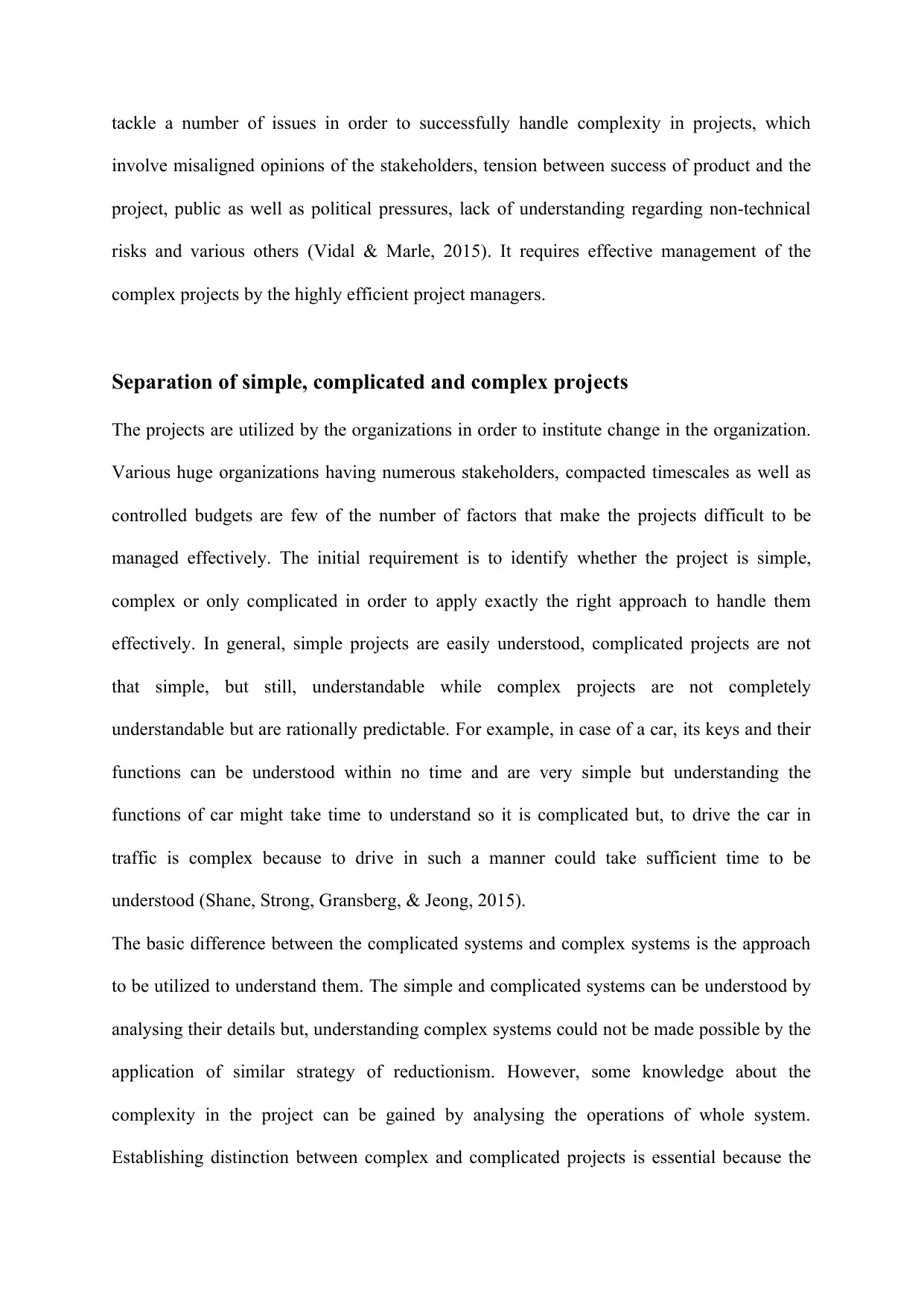
tackle a number of issues in order to successfully handle complexity in projects, which
involve misaligned opinions of the stakeholders, tension between success of product and the
project, public as well as political pressures, lack of understanding regarding non-technical
risks and various others (Vidal & Marle, 2015). It requires effective management of the
complex projects by the highly efficient project managers.
Separation of simple, complicated and complex projects
The projects are utilized by the organizations in order to institute change in the organization.
Various huge organizations having numerous stakeholders, compacted timescales as well as
controlled budgets are few of the number of factors that make the projects difficult to be
managed effectively. The initial requirement is to identify whether the project is simple,
complex or only complicated in order to apply exactly the right approach to handle them
effectively. In general, simple projects are easily understood, complicated projects are not
that simple, but still, understandable while complex projects are not completely
understandable but are rationally predictable. For example, in case of a car, its keys and their
functions can be understood within no time and are very simple but understanding the
functions of car might take time to understand so it is complicated but, to drive the car in
traffic is complex because to drive in such a manner could take sufficient time to be
understood (Shane, Strong, Gransberg, & Jeong, 2015).
The basic difference between the complicated systems and complex systems is the approach
to be utilized to understand them. The simple and complicated systems can be understood by
analysing their details but, understanding complex systems could not be made possible by the
application of similar strategy of reductionism. However, some knowledge about the
complexity in the project can be gained by analysing the operations of whole system.
Establishing distinction between complex and complicated projects is essential because the
involve misaligned opinions of the stakeholders, tension between success of product and the
project, public as well as political pressures, lack of understanding regarding non-technical
risks and various others (Vidal & Marle, 2015). It requires effective management of the
complex projects by the highly efficient project managers.
Separation of simple, complicated and complex projects
The projects are utilized by the organizations in order to institute change in the organization.
Various huge organizations having numerous stakeholders, compacted timescales as well as
controlled budgets are few of the number of factors that make the projects difficult to be
managed effectively. The initial requirement is to identify whether the project is simple,
complex or only complicated in order to apply exactly the right approach to handle them
effectively. In general, simple projects are easily understood, complicated projects are not
that simple, but still, understandable while complex projects are not completely
understandable but are rationally predictable. For example, in case of a car, its keys and their
functions can be understood within no time and are very simple but understanding the
functions of car might take time to understand so it is complicated but, to drive the car in
traffic is complex because to drive in such a manner could take sufficient time to be
understood (Shane, Strong, Gransberg, & Jeong, 2015).
The basic difference between the complicated systems and complex systems is the approach
to be utilized to understand them. The simple and complicated systems can be understood by
analysing their details but, understanding complex systems could not be made possible by the
application of similar strategy of reductionism. However, some knowledge about the
complexity in the project can be gained by analysing the operations of whole system.
Establishing distinction between complex and complicated projects is essential because the
Paraphrase This Document
Need a fresh take? Get an instant paraphrase of this document with our AI Paraphraser
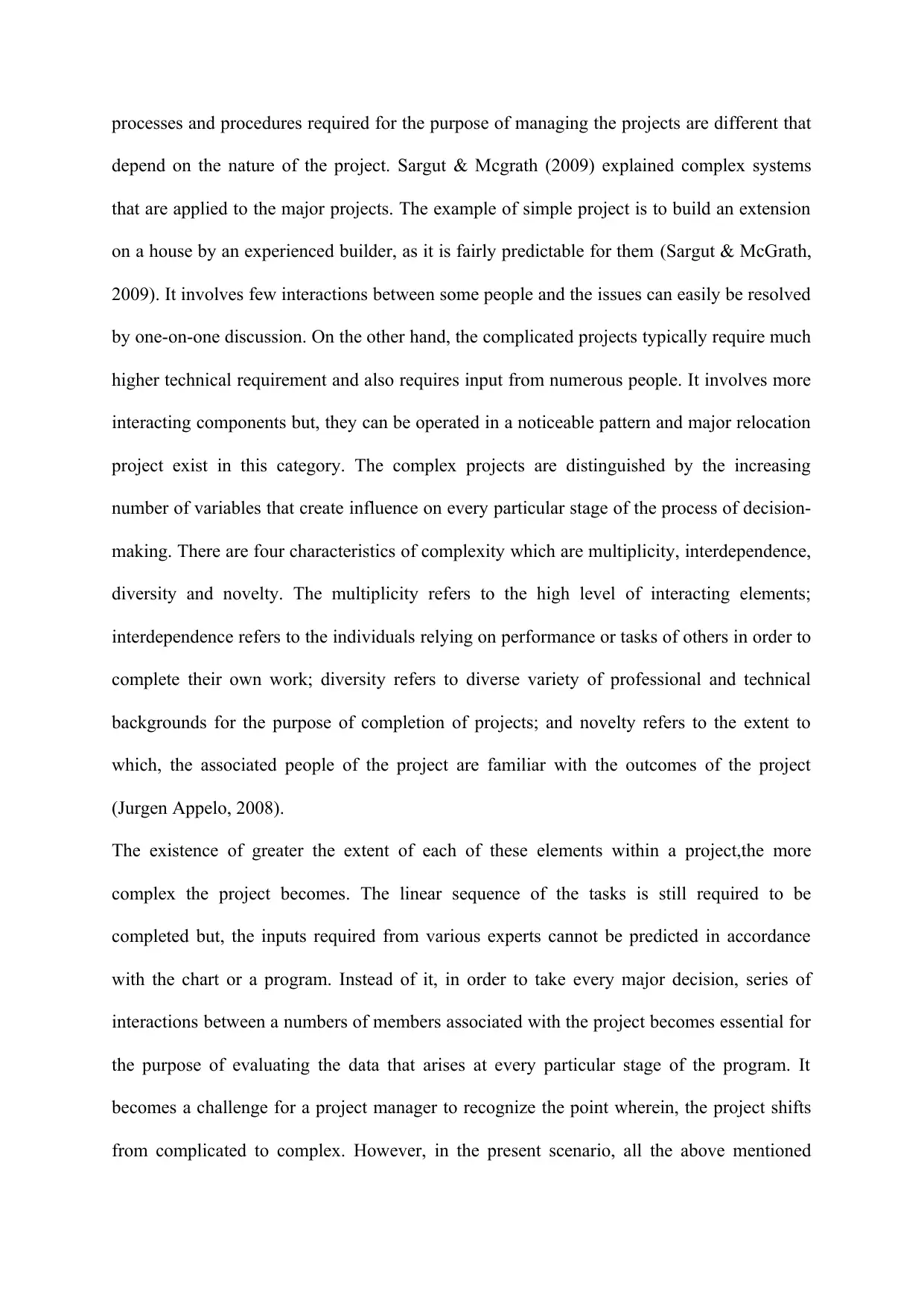
processes and procedures required for the purpose of managing the projects are different that
depend on the nature of the project. Sargut & Mcgrath (2009) explained complex systems
that are applied to the major projects. The example of simple project is to build an extension
on a house by an experienced builder, as it is fairly predictable for them (Sargut & McGrath,
2009). It involves few interactions between some people and the issues can easily be resolved
by one-on-one discussion. On the other hand, the complicated projects typically require much
higher technical requirement and also requires input from numerous people. It involves more
interacting components but, they can be operated in a noticeable pattern and major relocation
project exist in this category. The complex projects are distinguished by the increasing
number of variables that create influence on every particular stage of the process of decision-
making. There are four characteristics of complexity which are multiplicity, interdependence,
diversity and novelty. The multiplicity refers to the high level of interacting elements;
interdependence refers to the individuals relying on performance or tasks of others in order to
complete their own work; diversity refers to diverse variety of professional and technical
backgrounds for the purpose of completion of projects; and novelty refers to the extent to
which, the associated people of the project are familiar with the outcomes of the project
(Jurgen Appelo, 2008).
The existence of greater the extent of each of these elements within a project,the more
complex the project becomes. The linear sequence of the tasks is still required to be
completed but, the inputs required from various experts cannot be predicted in accordance
with the chart or a program. Instead of it, in order to take every major decision, series of
interactions between a numbers of members associated with the project becomes essential for
the purpose of evaluating the data that arises at every particular stage of the program. It
becomes a challenge for a project manager to recognize the point wherein, the project shifts
from complicated to complex. However, in the present scenario, all the above mentioned
depend on the nature of the project. Sargut & Mcgrath (2009) explained complex systems
that are applied to the major projects. The example of simple project is to build an extension
on a house by an experienced builder, as it is fairly predictable for them (Sargut & McGrath,
2009). It involves few interactions between some people and the issues can easily be resolved
by one-on-one discussion. On the other hand, the complicated projects typically require much
higher technical requirement and also requires input from numerous people. It involves more
interacting components but, they can be operated in a noticeable pattern and major relocation
project exist in this category. The complex projects are distinguished by the increasing
number of variables that create influence on every particular stage of the process of decision-
making. There are four characteristics of complexity which are multiplicity, interdependence,
diversity and novelty. The multiplicity refers to the high level of interacting elements;
interdependence refers to the individuals relying on performance or tasks of others in order to
complete their own work; diversity refers to diverse variety of professional and technical
backgrounds for the purpose of completion of projects; and novelty refers to the extent to
which, the associated people of the project are familiar with the outcomes of the project
(Jurgen Appelo, 2008).
The existence of greater the extent of each of these elements within a project,the more
complex the project becomes. The linear sequence of the tasks is still required to be
completed but, the inputs required from various experts cannot be predicted in accordance
with the chart or a program. Instead of it, in order to take every major decision, series of
interactions between a numbers of members associated with the project becomes essential for
the purpose of evaluating the data that arises at every particular stage of the program. It
becomes a challenge for a project manager to recognize the point wherein, the project shifts
from complicated to complex. However, in the present scenario, all the above mentioned
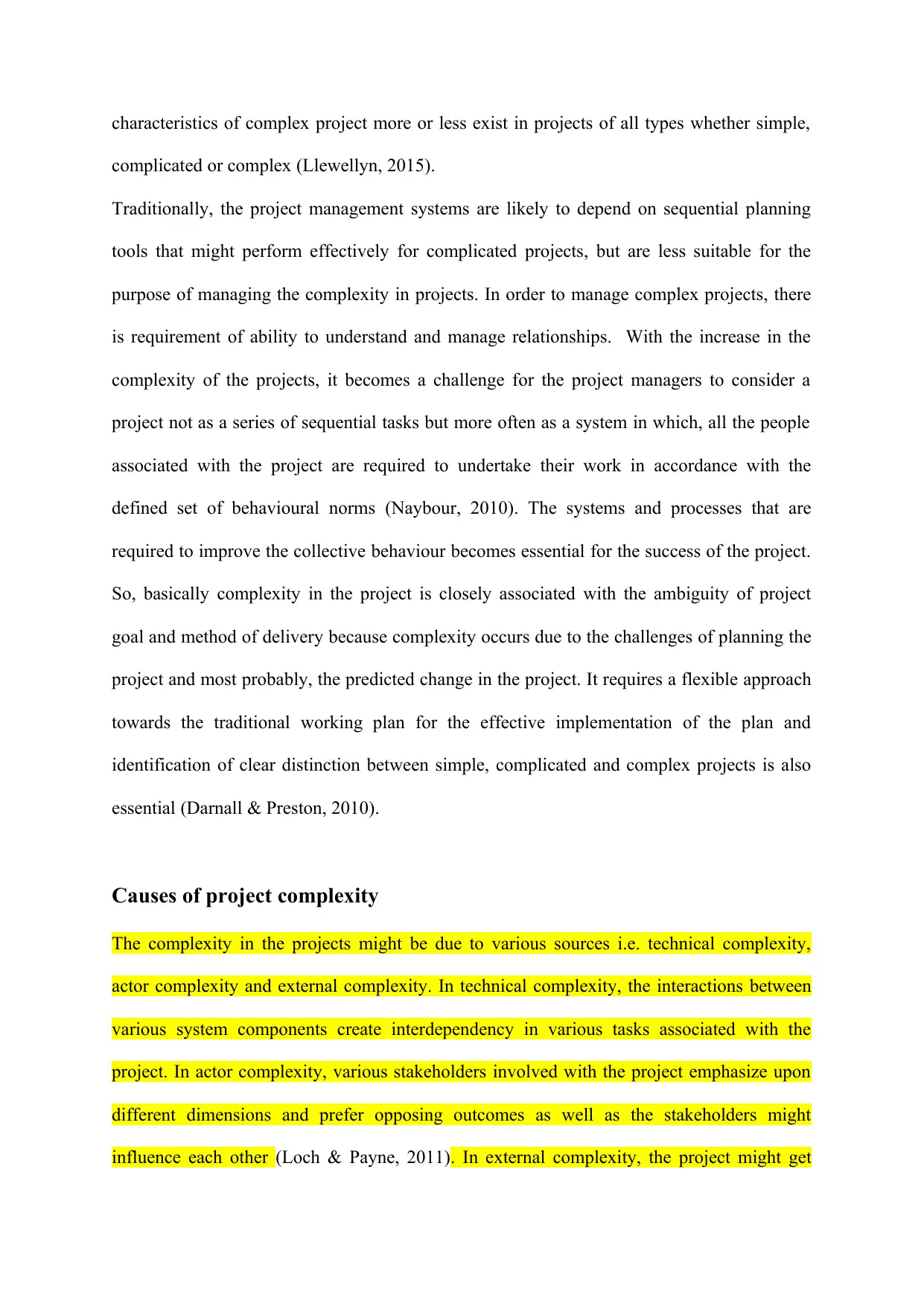
characteristics of complex project more or less exist in projects of all types whether simple,
complicated or complex (Llewellyn, 2015).
Traditionally, the project management systems are likely to depend on sequential planning
tools that might perform effectively for complicated projects, but are less suitable for the
purpose of managing the complexity in projects. In order to manage complex projects, there
is requirement of ability to understand and manage relationships. With the increase in the
complexity of the projects, it becomes a challenge for the project managers to consider a
project not as a series of sequential tasks but more often as a system in which, all the people
associated with the project are required to undertake their work in accordance with the
defined set of behavioural norms (Naybour, 2010). The systems and processes that are
required to improve the collective behaviour becomes essential for the success of the project.
So, basically complexity in the project is closely associated with the ambiguity of project
goal and method of delivery because complexity occurs due to the challenges of planning the
project and most probably, the predicted change in the project. It requires a flexible approach
towards the traditional working plan for the effective implementation of the plan and
identification of clear distinction between simple, complicated and complex projects is also
essential (Darnall & Preston, 2010).
Causes of project complexity
The complexity in the projects might be due to various sources i.e. technical complexity,
actor complexity and external complexity. In technical complexity, the interactions between
various system components create interdependency in various tasks associated with the
project. In actor complexity, various stakeholders involved with the project emphasize upon
different dimensions and prefer opposing outcomes as well as the stakeholders might
influence each other (Loch & Payne, 2011). In external complexity, the project might get
complicated or complex (Llewellyn, 2015).
Traditionally, the project management systems are likely to depend on sequential planning
tools that might perform effectively for complicated projects, but are less suitable for the
purpose of managing the complexity in projects. In order to manage complex projects, there
is requirement of ability to understand and manage relationships. With the increase in the
complexity of the projects, it becomes a challenge for the project managers to consider a
project not as a series of sequential tasks but more often as a system in which, all the people
associated with the project are required to undertake their work in accordance with the
defined set of behavioural norms (Naybour, 2010). The systems and processes that are
required to improve the collective behaviour becomes essential for the success of the project.
So, basically complexity in the project is closely associated with the ambiguity of project
goal and method of delivery because complexity occurs due to the challenges of planning the
project and most probably, the predicted change in the project. It requires a flexible approach
towards the traditional working plan for the effective implementation of the plan and
identification of clear distinction between simple, complicated and complex projects is also
essential (Darnall & Preston, 2010).
Causes of project complexity
The complexity in the projects might be due to various sources i.e. technical complexity,
actor complexity and external complexity. In technical complexity, the interactions between
various system components create interdependency in various tasks associated with the
project. In actor complexity, various stakeholders involved with the project emphasize upon
different dimensions and prefer opposing outcomes as well as the stakeholders might
influence each other (Loch & Payne, 2011). In external complexity, the project might get
⊘ This is a preview!⊘
Do you want full access?
Subscribe today to unlock all pages.

Trusted by 1+ million students worldwide
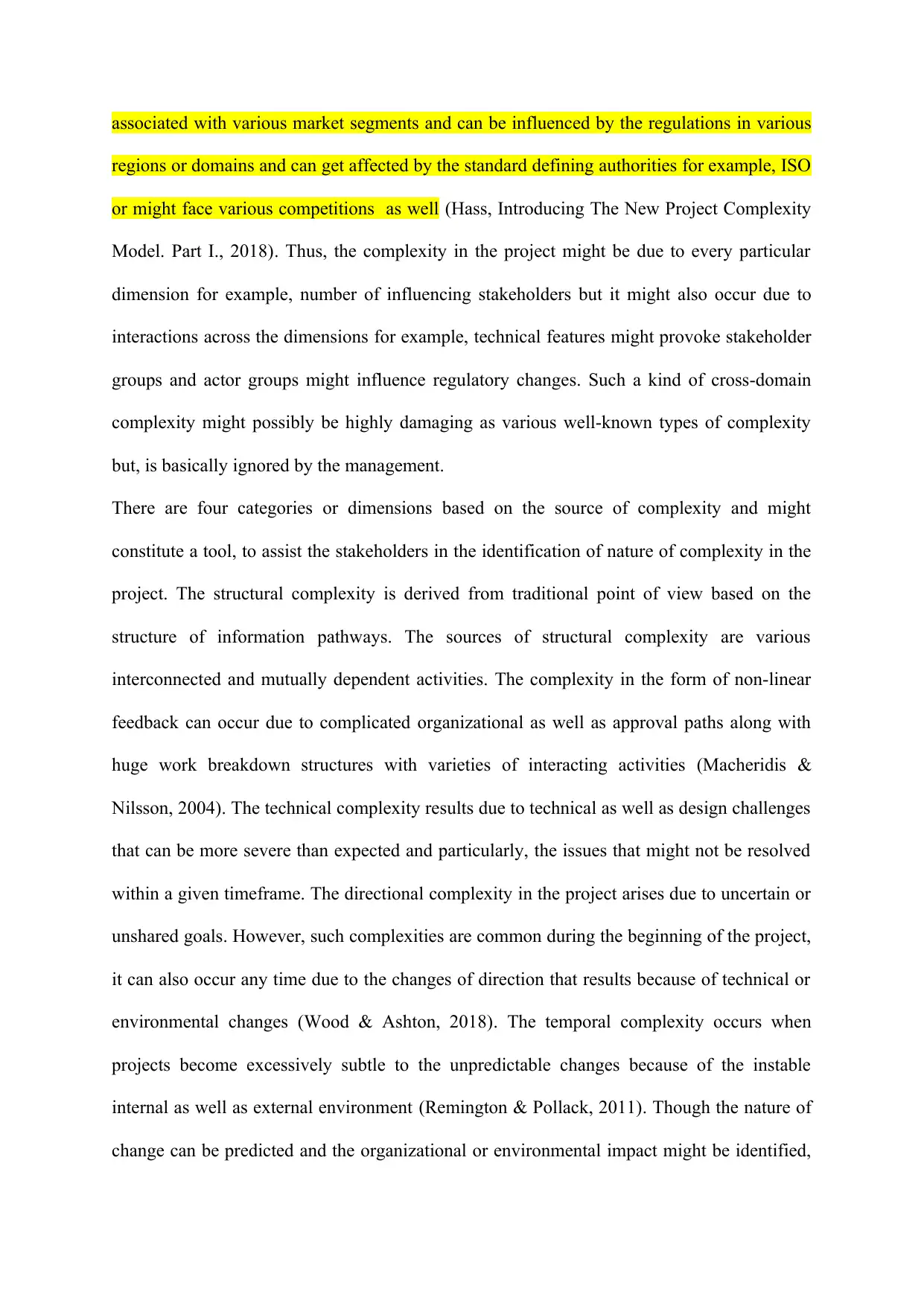
associated with various market segments and can be influenced by the regulations in various
regions or domains and can get affected by the standard defining authorities for example, ISO
or might face various competitions as well (Hass, Introducing The New Project Complexity
Model. Part I., 2018). Thus, the complexity in the project might be due to every particular
dimension for example, number of influencing stakeholders but it might also occur due to
interactions across the dimensions for example, technical features might provoke stakeholder
groups and actor groups might influence regulatory changes. Such a kind of cross-domain
complexity might possibly be highly damaging as various well-known types of complexity
but, is basically ignored by the management.
There are four categories or dimensions based on the source of complexity and might
constitute a tool, to assist the stakeholders in the identification of nature of complexity in the
project. The structural complexity is derived from traditional point of view based on the
structure of information pathways. The sources of structural complexity are various
interconnected and mutually dependent activities. The complexity in the form of non-linear
feedback can occur due to complicated organizational as well as approval paths along with
huge work breakdown structures with varieties of interacting activities (Macheridis &
Nilsson, 2004). The technical complexity results due to technical as well as design challenges
that can be more severe than expected and particularly, the issues that might not be resolved
within a given timeframe. The directional complexity in the project arises due to uncertain or
unshared goals. However, such complexities are common during the beginning of the project,
it can also occur any time due to the changes of direction that results because of technical or
environmental changes (Wood & Ashton, 2018). The temporal complexity occurs when
projects become excessively subtle to the unpredictable changes because of the instable
internal as well as external environment (Remington & Pollack, 2011). Though the nature of
change can be predicted and the organizational or environmental impact might be identified,
regions or domains and can get affected by the standard defining authorities for example, ISO
or might face various competitions as well (Hass, Introducing The New Project Complexity
Model. Part I., 2018). Thus, the complexity in the project might be due to every particular
dimension for example, number of influencing stakeholders but it might also occur due to
interactions across the dimensions for example, technical features might provoke stakeholder
groups and actor groups might influence regulatory changes. Such a kind of cross-domain
complexity might possibly be highly damaging as various well-known types of complexity
but, is basically ignored by the management.
There are four categories or dimensions based on the source of complexity and might
constitute a tool, to assist the stakeholders in the identification of nature of complexity in the
project. The structural complexity is derived from traditional point of view based on the
structure of information pathways. The sources of structural complexity are various
interconnected and mutually dependent activities. The complexity in the form of non-linear
feedback can occur due to complicated organizational as well as approval paths along with
huge work breakdown structures with varieties of interacting activities (Macheridis &
Nilsson, 2004). The technical complexity results due to technical as well as design challenges
that can be more severe than expected and particularly, the issues that might not be resolved
within a given timeframe. The directional complexity in the project arises due to uncertain or
unshared goals. However, such complexities are common during the beginning of the project,
it can also occur any time due to the changes of direction that results because of technical or
environmental changes (Wood & Ashton, 2018). The temporal complexity occurs when
projects become excessively subtle to the unpredictable changes because of the instable
internal as well as external environment (Remington & Pollack, 2011). Though the nature of
change can be predicted and the organizational or environmental impact might be identified,
Paraphrase This Document
Need a fresh take? Get an instant paraphrase of this document with our AI Paraphraser
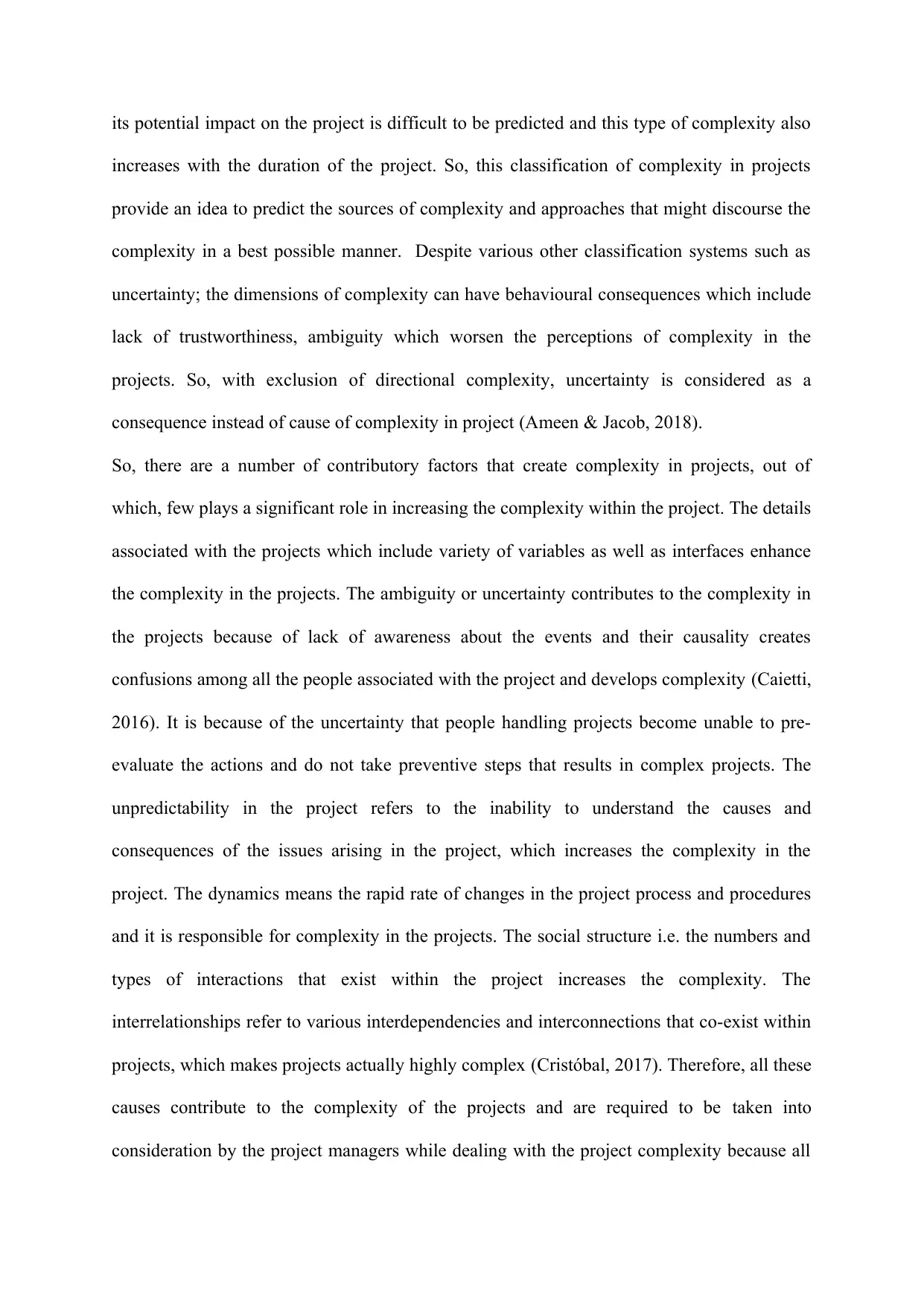
its potential impact on the project is difficult to be predicted and this type of complexity also
increases with the duration of the project. So, this classification of complexity in projects
provide an idea to predict the sources of complexity and approaches that might discourse the
complexity in a best possible manner. Despite various other classification systems such as
uncertainty; the dimensions of complexity can have behavioural consequences which include
lack of trustworthiness, ambiguity which worsen the perceptions of complexity in the
projects. So, with exclusion of directional complexity, uncertainty is considered as a
consequence instead of cause of complexity in project (Ameen & Jacob, 2018).
So, there are a number of contributory factors that create complexity in projects, out of
which, few plays a significant role in increasing the complexity within the project. The details
associated with the projects which include variety of variables as well as interfaces enhance
the complexity in the projects. The ambiguity or uncertainty contributes to the complexity in
the projects because of lack of awareness about the events and their causality creates
confusions among all the people associated with the project and develops complexity (Caietti,
2016). It is because of the uncertainty that people handling projects become unable to pre-
evaluate the actions and do not take preventive steps that results in complex projects. The
unpredictability in the project refers to the inability to understand the causes and
consequences of the issues arising in the project, which increases the complexity in the
project. The dynamics means the rapid rate of changes in the project process and procedures
and it is responsible for complexity in the projects. The social structure i.e. the numbers and
types of interactions that exist within the project increases the complexity. The
interrelationships refer to various interdependencies and interconnections that co-exist within
projects, which makes projects actually highly complex (Cristóbal, 2017). Therefore, all these
causes contribute to the complexity of the projects and are required to be taken into
consideration by the project managers while dealing with the project complexity because all
increases with the duration of the project. So, this classification of complexity in projects
provide an idea to predict the sources of complexity and approaches that might discourse the
complexity in a best possible manner. Despite various other classification systems such as
uncertainty; the dimensions of complexity can have behavioural consequences which include
lack of trustworthiness, ambiguity which worsen the perceptions of complexity in the
projects. So, with exclusion of directional complexity, uncertainty is considered as a
consequence instead of cause of complexity in project (Ameen & Jacob, 2018).
So, there are a number of contributory factors that create complexity in projects, out of
which, few plays a significant role in increasing the complexity within the project. The details
associated with the projects which include variety of variables as well as interfaces enhance
the complexity in the projects. The ambiguity or uncertainty contributes to the complexity in
the projects because of lack of awareness about the events and their causality creates
confusions among all the people associated with the project and develops complexity (Caietti,
2016). It is because of the uncertainty that people handling projects become unable to pre-
evaluate the actions and do not take preventive steps that results in complex projects. The
unpredictability in the project refers to the inability to understand the causes and
consequences of the issues arising in the project, which increases the complexity in the
project. The dynamics means the rapid rate of changes in the project process and procedures
and it is responsible for complexity in the projects. The social structure i.e. the numbers and
types of interactions that exist within the project increases the complexity. The
interrelationships refer to various interdependencies and interconnections that co-exist within
projects, which makes projects actually highly complex (Cristóbal, 2017). Therefore, all these
causes contribute to the complexity of the projects and are required to be taken into
consideration by the project managers while dealing with the project complexity because all
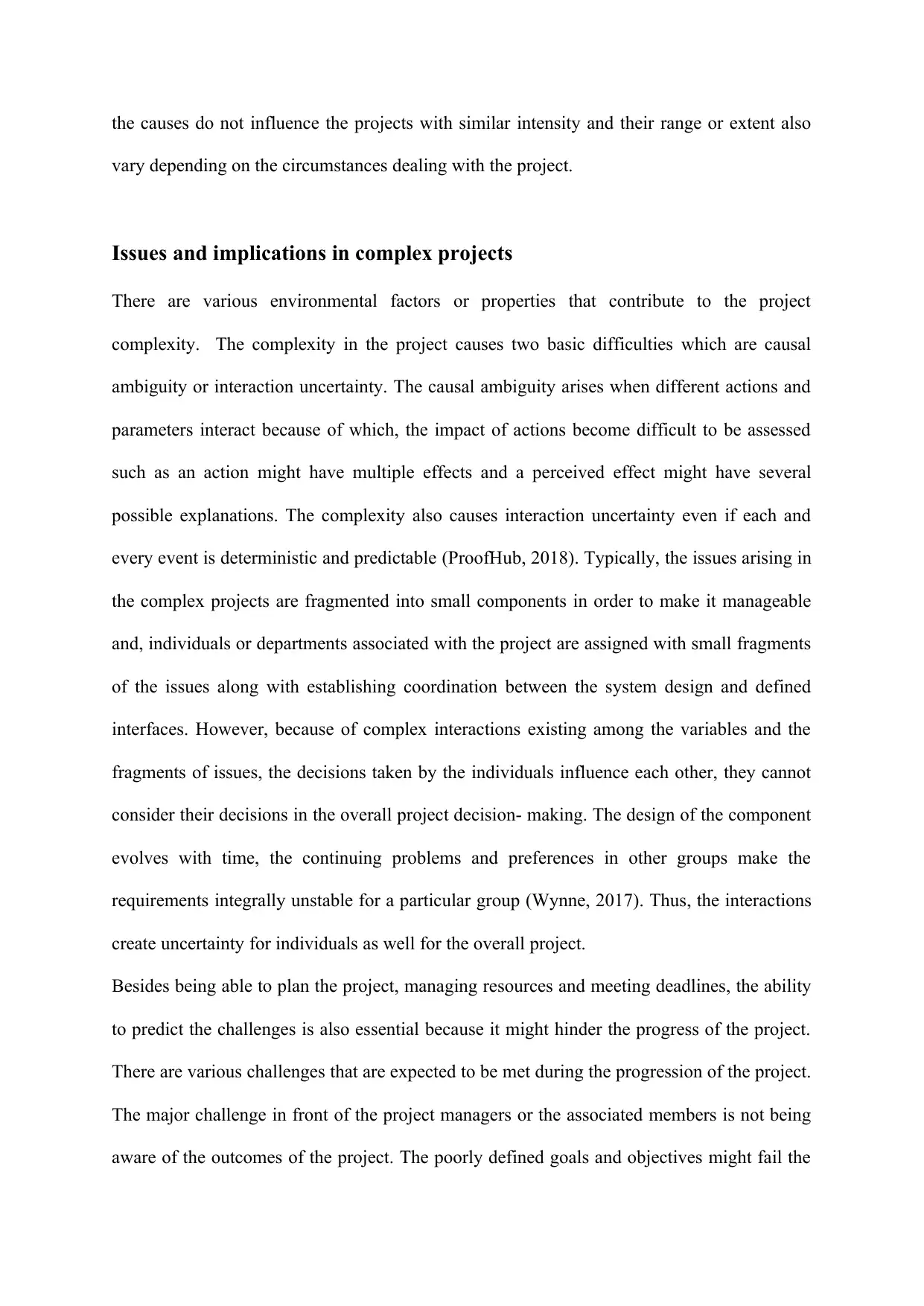
the causes do not influence the projects with similar intensity and their range or extent also
vary depending on the circumstances dealing with the project.
Issues and implications in complex projects
There are various environmental factors or properties that contribute to the project
complexity. The complexity in the project causes two basic difficulties which are causal
ambiguity or interaction uncertainty. The causal ambiguity arises when different actions and
parameters interact because of which, the impact of actions become difficult to be assessed
such as an action might have multiple effects and a perceived effect might have several
possible explanations. The complexity also causes interaction uncertainty even if each and
every event is deterministic and predictable (ProofHub, 2018). Typically, the issues arising in
the complex projects are fragmented into small components in order to make it manageable
and, individuals or departments associated with the project are assigned with small fragments
of the issues along with establishing coordination between the system design and defined
interfaces. However, because of complex interactions existing among the variables and the
fragments of issues, the decisions taken by the individuals influence each other, they cannot
consider their decisions in the overall project decision- making. The design of the component
evolves with time, the continuing problems and preferences in other groups make the
requirements integrally unstable for a particular group (Wynne, 2017). Thus, the interactions
create uncertainty for individuals as well for the overall project.
Besides being able to plan the project, managing resources and meeting deadlines, the ability
to predict the challenges is also essential because it might hinder the progress of the project.
There are various challenges that are expected to be met during the progression of the project.
The major challenge in front of the project managers or the associated members is not being
aware of the outcomes of the project. The poorly defined goals and objectives might fail the
vary depending on the circumstances dealing with the project.
Issues and implications in complex projects
There are various environmental factors or properties that contribute to the project
complexity. The complexity in the project causes two basic difficulties which are causal
ambiguity or interaction uncertainty. The causal ambiguity arises when different actions and
parameters interact because of which, the impact of actions become difficult to be assessed
such as an action might have multiple effects and a perceived effect might have several
possible explanations. The complexity also causes interaction uncertainty even if each and
every event is deterministic and predictable (ProofHub, 2018). Typically, the issues arising in
the complex projects are fragmented into small components in order to make it manageable
and, individuals or departments associated with the project are assigned with small fragments
of the issues along with establishing coordination between the system design and defined
interfaces. However, because of complex interactions existing among the variables and the
fragments of issues, the decisions taken by the individuals influence each other, they cannot
consider their decisions in the overall project decision- making. The design of the component
evolves with time, the continuing problems and preferences in other groups make the
requirements integrally unstable for a particular group (Wynne, 2017). Thus, the interactions
create uncertainty for individuals as well for the overall project.
Besides being able to plan the project, managing resources and meeting deadlines, the ability
to predict the challenges is also essential because it might hinder the progress of the project.
There are various challenges that are expected to be met during the progression of the project.
The major challenge in front of the project managers or the associated members is not being
aware of the outcomes of the project. The poorly defined goals and objectives might fail the
⊘ This is a preview!⊘
Do you want full access?
Subscribe today to unlock all pages.

Trusted by 1+ million students worldwide
1 out of 23
Related Documents
Your All-in-One AI-Powered Toolkit for Academic Success.
+13062052269
info@desklib.com
Available 24*7 on WhatsApp / Email
![[object Object]](/_next/static/media/star-bottom.7253800d.svg)
Unlock your academic potential
Copyright © 2020–2025 A2Z Services. All Rights Reserved. Developed and managed by ZUCOL.




